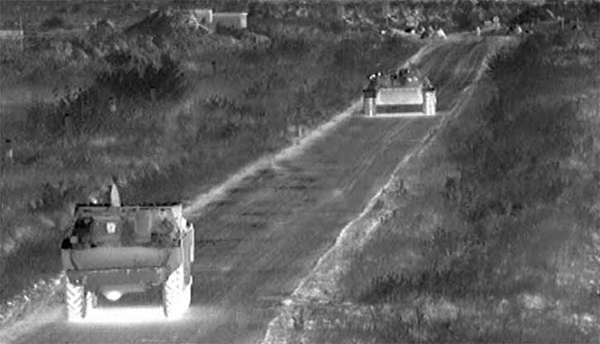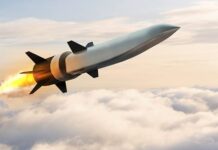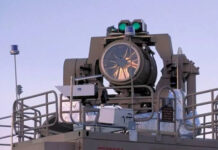
Armed Forces Requirement is Pegged at $2900 mn
The growing need for national security and surveillance during both day and night, adverse weather and limited visibility conditions has led to an increased demand of Night Vision Devices (NVDs). NVD is an optoelectronic device that allows the production of images in lighting conditions that are approaching total darkness. An image is the conversion of both visible light and near-infrared light to visible light. NVDs, are used to intensify human sight under very low light conditions and are apparently simple system constructed from three main blocks: optical objective, picture intensifier tube and ocular eyepiece.
There are several types of NVDs. Infrared imaging systems focus infrared light on a scene. Infrared is beyond the light spectrum visible to humans, so the beam itself is undetectable. Image-converting technology transforms the scene illuminated by the infrared into a visible image. Thermal imaging systems work in a similar way, converting the pattern of heat emitted by the objects into a visual image. The NVDs perfected for wartime use amplify images picked up in minimal light, such as starlight, into visible images. The view through a passive NVD may be from 20,000 to 50,000 times brighter than what the unaided eye could see.
NVD are frequently used by the armed forces and land law enforcement agencies, however, they are available for civilian usage as well. Most NVDs consist of optical components such as telescopic lenses or mirrors. Night vision devices contain an IR illuminator, which makes them an active NVD. There are different types of NVDs which are used by the armed forces. They could be classified by either the type or platform usage specific.
Classification by Type
Thermal imager (TI). Thermal imagers are a kind of thermographic camera that is usually used for firefighting. They are typically handheld but may be helmet-mounted as well. The construction of such cameras involves heat and water-resistant housing and contains five major components, i.e., optic systems, detector, amplifier, signal processing and display. This technology is further categorized into cooled and uncooled thermal imaging cameras.
Thermal imagers weapon night sight. This is completely passive infrared weapon sighting system that allows users to identify and detect heat signatures of individuals or objects in day, night, rainy or smoky conditions. An external flash infrared light source is not required. It is further categorized as monocular and binocular.
Laser based night sights. Laser range finder is a device which uses a laser beam to determine the distance to an object up a distance of about 20 kms. Laser designator is a laser light source used to select objects or installations to be attacked or destroyed in warfare.
Classification By usage
Land (Tank surveillance). Thermal Imaging Stand-Alone System is an advanced thermal imaging and fire control upgrade system which serves as a modular compact and stand-alone upgrade for many T-family tanks and features an advanced, high-performance thermal imaging system, with a digital ballistic computer, gunner and commander display. Thermal Imaging Fire Control System is a state-of-the-art, robust, compact, modular and a user-friendly gunner sight. It is a long-range system which is optimal for both day and night, stationary and on the move operations, designed for rapid and high-accuracy target engagement in all kinds of combat scenarios. It has an Eye-Safe Long-Range Laser Rangefinder and has integrated electronic control unit.
Sea (Marine platform surveillance). Night vision devices are used in naval ships and boats for surveillance and to assist in other activities. It helps navigate in all circumstances, detect other vessels, assist in overboard searches, to secure vessel in the harbour and at open water (anti-piracy) and give the user a good overview of what is happening in the dark. A thermal imaging camera is very effective in maritime environments.
Air (Aircraft and UAVs surveillance). Night vision devices are used by pilots, aircraft and UAVs. Few of them are:
• EOIR Payload for MI-17 Helicopter – It is a day and night surveillance system which includes a daylight colour camera, a third generation 3-5 µm thermal imager, along with eye-safe laser rangefinder (ELRF), automatic video tracker, grip and display, video data recorder as well as command and control capabilities. It has a wide range of interfaces, enabling integration with various systems, such as computer and GPS.
• NVS 6-3XT Aviator Night Vision Imaging System – It enables the pilot to operate their aircrafts in the darkest environment, giving them clear visibility and facilitate them to navigate during take-off, landing and performing other operations. The adjustable eyepieces allow improvised eye relief up to 25 mm, which enable comfortable viewing, regardless of the eyepiece positioning.
• Night vision UAV-Thermal imager for the UAV ranges from upto 7.5km to about 40 Kms
• Individual surveillance (Passive night vision Binoculars/goggles).
Market Insights
The number of military equipment and vehicles with vision systems has increased significantly over the past few years. These multi-sensor electro-optical systems include thermal cameras and high-resolution color cameras. Many countries are focussing on retrofitting the existing equipment and vehicles with advanced EO/IR systems due to their limited defence budget for procurement of new platforms. Usage of unmanned systems such as unmanned aerial vehicles (UAVs) is also contributing to the increasing share of NVDs in the defence market. Moreover, improved efficiency and accuracy of NVDs is increasing their use across various platforms.
The global military electro-optical and infrared systems market is projected to register a CAGR of 2.51%, reaching US$9,314.13 million by 2026. By platform, the air-based segment held the largest market share (54.26%) in 2020. The sea-based segment is expected to show the highest CAGR (2.67%) during the forecast period.
With rapid developments in the segment, the competition in this market is high. New entrants are also venturing into this segment owing to its profitability with latest technologies. Transfer of technology between players is enabling mutual growth.
With the focus on national security, most countries have provisions of several man portable, manned and unmanned platforms in their defence budgets. Many of these require NVDs / EO/IR sensors for patrolling, surveillance, reconnaissance, and search and rescue operations. Therefore, growing military budgets of countries across the globe, R&D in advanced infrared imaging technologies, to develop sensors that can provide high-resolution images (to locate and identify targets at much longer ranges than is possible with existing optical systems), need for better sensors to enhance situational awareness of the military personnel on the battlespace are some of the major driving factors of this market.
Simultaneously, various design challenges, technological constraints, supply chain risks, the evolving global crisis, and unprecedented factors, like the advent of the COVID-19 pandemic, could affect the market negatively in the near future.
Integration of new technologies on existing systems is one of the main design and technical constraints. It also affects the interoperability of a wide range of technologies. For instance, the integration of EO/IR systems onboard an UAVs has given rise to some of the most advanced design challenges for developers. It also adds to the overall weight of the UAVs.
In order to have a competitive price for their products, the revenue stream of players in this segment is significantly affected due to low profit margins.
Many times, production cycles are also delayed due to prolonged shortage of critical components from major suppliers. Certain components such as sensors should also adhere to specific quality standards contributing to high prices and supply interruption risks.
The EO/IR market could be split into land-based, air-based and naval-based systems. The global market (in US$ m) for each of these is tabulated below:
Year Land Air Naval
2020 1,519 4,348 2,145
2026 1,736 5,059 2,517
The Indian EO/IR market was US$600.98 m in 2020 and is projected to reach US$737.77 m by 2026. The Indian EO/IR market (in US$ m) across the three domains is tabulated below:
Year Land Air Naval
2020 109 331 161
2026 132 406 199
NVDs in India
The Technology Perspective and Capability Roadmap (TPCR) 2018 of India highlights, among others, special optical payloads for the army, long range electro-optical sensors for the navy, and helmet mounted night vision devices for the air force. India’s Main Battle Tank (MBT) Arjun has a thermal imager that provides night vision facility to soldiers to observe and engage targets in total darkness and in the presence of smoke, dust, haze and light camouflage. Targets can be ranged accurately using the laser range finder of the main sight.
India’s Defence Research and Development Organization (DRDO) is involved in the development of NVDs. Instruments Research and Development Establishment (IRDE), one of the laboratories under the Electronics and Communication Systems (ECS) cluster of DRDO, designs, develops and conducts research in optical and electro-optical instruments for the defence services. Its key products are Gap Measuring Device Mk III, electro-optical fire control system for armoured vehicles and naval ships, holographic sight, Helmet Mounted Thermal Imaging Camera (HMTIC), Multi-Purpose Reflex Weapon Sight (MRWS) Light Weight Portable Laser Target Designator for Indian Air Force and Commander’s TI for T-90 Tank. DRDO has also developed a portable dual-role EOCM laser system weighing 30kg which has an operational range of 2.5 km /suitable. It has a day/night sighting telescope target acquisition and can be used for both anti-sensor and dazzling applications.
Army Design Bureau (ADB) set up by the Indian Army to promote the production of home-grown weapons, especially using niche technologies has developed a helmet mounted AI-powered personalized night vision unit that warns soldiers of any unusual activity across regions with a restricted line of sight. Along with the helmet, the companion wristband also vibrates when the unit picks up signs of any movement in the soldier’s proximity.
Ordnance Factory Dehradun (OFDUN), part of Indian Optel Limited (IOL), one of the seven newly formed defence company carved out of the erstwhile Ordnance Factory Board (OFB) produces a wide range of electro-optics instruments and laser-based sighting systems for meeting the requirements of military, para-military and special armed forces. Its key products include Passive Night Sights for 12.7 mm AD gun, Passive Night Vision Goggles 102A, Driver’s Passive Night Periscope for T-55 Tank, Bino Night Vision Passive Cased 101A, Passive Night Sight for AK-47, Infantry passive night sights for the 5.56 mm INSAS rifle, and for the 84 mm.
BEL has been exporting products including electro optic systems and electro optic fire control systems amongst others to the USA, UK, Russia, Italy, Brazil, Germany, France, Israel, Indonesia, Honduras, Malaysia, Maldives, Mauritius, Myanmar, Namibia, Seychelles, South Africa and many other friendly countries. Segments like electro optic systems and electronic warfare and avionics systems, radars and weapon systems, communication and network centric systems, tank electronics, gun upgrades, shall act as growth drivers for BEL in the coming years.
The private industry in India is also involved in the design and development of NVDs. For instance, a well-established firm in Kanpur manufactures a highly advanced night vision and thermal that are compatible with a host of commercially available combat equipment. They can be mounted easily using existing mounting and attachment subsystems. Another firm based out of Bangalore manufactures II based Passive Night Vision Binoculars, II based passive night vision goggles, handheld TI sight (Uncooled Handheld Thermal Imaging Binocular). A private company headquartered at Hyderabad manufactures Night vision monocular, night vision binoculars, bi-ocular night vision devices, aviation night vision goggles, etc.
In July 2018, Rafael commissioned a US$9.88 million facility in Hyderabad for developing a wide range of advanced capabilities, like command control and guidance, electro-optics, remote weapon systems, precision guided munitions, and system engineering for system integration. In 2019, India placed an order for P-8I maritime reconnaissance aircraft, scheduled to be delivered to the Navy starting from May 2020. They sport the L-3 Communications Wescam MX-20HD digital Electro-Optical and Infrared (EO/IR) multi-spectral sensor turret, along with other specifications requested by the Indian Navy.
In 2019, Controp Precession Technologies partnered with BEL to supply a Ruggedized Day/Night Optronic sensor system for the Indian Armed Forces. These can be integrated into a host system, and it features a daylight CCD Camera and a ‘Thermal Imaging Camera’, with a continuous optical zoom lens. In 2020, Controp was contracted by DRDO, to supply the company’s iSKY-50HD Electro-Optical, and Infrared (EO/IR) system, to be employed in UAVs. The iSky-50HD system makes use of highly sensitive multi-spectral sensors that are gyro-stabilized and have advanced image processing capabilities, which make them helpful for a variety of airborne applications. The US administration approved the sale of the Integrated Air Defense Weapon Systems (IADWS) to India in 2020. The entire deal is valued around US$1.9 billion. A part of the deal were M4A1 rifles, 5.56 cartridges, EO/IR systems, and hand-held remote terminal. As part of another deal, Lockheed Marin will be supplying an electro-optical fire-control system to help India’s AH-64 Apache attack-helicopter’s crew to fire weapons accurately and navigate better in adverse weather and in the night.
In August 2021, the Indian Army initiated the indigenous upgrade of 811 of its licence built BMP-2/2K ‘Sarath’ infantry combat vehicles (ICVs) by equipping them with more powerful engines, night fighting capability and varied advanced systems. The Army despatched a project sanction order (PSO) to 12 domestic private and public sector companies – referred to as Development Agencies (DAs) – to produce a retrofitted prototype within 52 weeks (or by 31 July 2022) for user trials. The BMP-2 upgrade would be processed under the Buy (Indian-IDDM) category of the DAP 2020. The projected ICV upgrade would include fitting them with more powerful engines to replace their present UTD20/2 300hp power packs, third-generation thermal imager-based gunner and panoramic sights, modern fire control systems and automatic target trackers. The retrofit would also encompass upgrading the platforms on-board weapon systems that include a 30mm 2A42 auto-canon with dual ammunition feeds, capable of firing 9M113 Konkurs wire-guided anti-tank guided missiles (ATGMs) and a secondary coaxial 7.62x54mm machine gun.
In December 2021, the Defence Procurement Board (DPB) cleared the purchase of 29,760 image intensifiers worth Rs 1410 crore to go with the Sig Sauers.

















